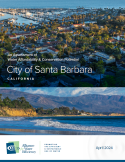An Assessment of Water Affordability & Conservation Potential in the City of Santa Barbara, CA

Affordability is a growing concern as water and wastewater rates rise to account for the increasing costs due to aging infrastructure, extreme weather events, climate change, regulations, and inflation, to name a few. Investing in water conservation and efficiency is one strategy to keep water and wastewater bills affordable. As part of AWE’s mission to promote the efficient and sustainable use of water, AWE is conducting research to better understand how water conservation and efficiency can help lower water bills for low-income customers. To learn more about AWE’s affordability-centered work, explore our recent affordability assessments in Houston, TX, and Long Beach, CA.
AWE’s report, An Assessment of Water Affordability and Conservation Potential in the City of Santa Barbara, evaluates water affordability in Santa Barbara and the extent to which water efficiency and conservation strategies can help families decrease their water and wastewater bills, especially in California-designated DAC communities.
Statewide assessments of affordability only look at cities as a whole and suggest no water affordability concerns in the City of Santa Barbara, however, a city is more than a single data point. This study leveraged Census data, monthly household-level water consumption, and water and wastewater billing data between FY18- FY23 to reveal impacts to the lowest income households, as well as the variation in affordability issues across different areas of the City. By coupling data analysis with local community perspectives through a community engagement process, the study advises on how to improve water affordability and expand access to resources in historically underserved communities.
The report demonstrates:
- The City of Santa Barbara residents have experienced moderate increases in utility bills over FY18-FY23, and water affordability challenges tend to be concentrated in a handful of Census tracts with specific demographic characteristics, including but not limited to low or fixed-income, renter, and non-English speaking populations.
- The lowest-income households are spending an average of about 4% of their annual income on water and wastewater bills. Although there is notable variation in water use and incomes across the community.
- Bill assistance programs and water conservation strategies can significantly make a difference; various strategies were assessed and could lower household bills by 10-33% and 7-15%, respectively.
- Stories and perspectives from local community organizations and residents indicate that while water affordability is a challenge for some, it is only one piece of the larger cost of living challenge faced by community members in Santa Barbara. Community members and customers need clear and consistent education on water affordability, water conservation, and the resources available to them to better manage their bills and water use.
- Like many other communities across the country, significant rate increases in the City of Santa Barbara are needed to continue supporting sustainable and reliable water systems amidst a changing climate. As the City explores future rate changes, adopting and enhancing strategies to assist households struggling to regularly pay water and wastewater bills will be even more important moving forward.





